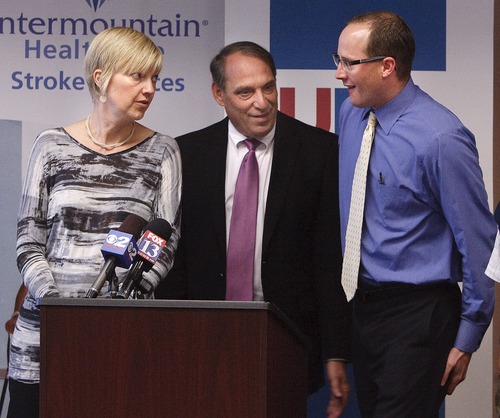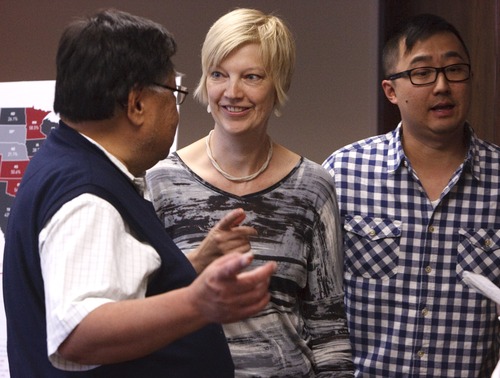This is an archived article that was published on sltrib.com in 2013, and information in the article may be outdated. It is provided only for personal research purposes and may not be reprinted.
Utah has the nation's highest percentage of stroke patients who receive clot-busting drugs in the "golden hour," within 60 minutes of arriving at a hospital emergency room, shows an analysis by the American Stroke Association.
The study, highlighted Thursday at a Utah Hospital Association press event, measured "door-to-needle" time, or the amount of time it takes to give eligible stroke patients an intravenous dose of a drug called tissue plasminogen activator (tPA). It can reduce the effects of stroke, including permanent disability.
In Utah, the study found 62 percent of patients in 2012 received the drug on time, well above the national average of 43 percent. The next best states were Colorado, Minnesota and Oklahoma and West Virginia.
"Patients that come into hospitals in the state of Utah can feel comfortable they have a better chance at leaving the hospital symptom-free than anywhere else in the country," said Kevin Call, a neurologist for Intermountain Healthcare and chairman of the Utah Stroke Task Force.
The data were collected from 800 U.S. hospitals that participate in the American Stroke Association's "Get with the Guidelines" program to train hospitals on proven protocols for speeding stroke response times. Seventeen of Utah's 60 hospitals participated.
Giving rise to the program was a 2009 University of California, Los Angeles study that found only 29.1 percent of stroke patients had door-to-needle times of under an hour.
Administering tPA within that window is a collaborative effort, starting with the patient who must first call 911.
Jennifer Majersik, director of University Hospital's stroke center, said many patients ignore or fail to recognize the symptoms.
Then, when they get to a hospital, they have to be properly diagnosed, which can be difficult, "even in expert hands," and requires a CT scan and lab tests, she said. "It can take some places more than an hour to get labs back. The guidelines say it has to happen under 25 minutes."
Majersik credits Utah's success to a two-year push to urge smaller, rural health centers to become "stroke receiving" facilities.
Today there are 22 such facilities in the state. In 2010, there were only two, which Majersik said led to geographical disparities in care.
Paramedics with potential stroke patients bypass ill-equipped hospitals to get them to a receiving facility or one of eight "primary stroke centers" in Utah.
Stroke is the third leading cause of death in Utah and a leading cause of disability. It can strike at any age.
The drug tPA can only be given to patients having an ischemic stroke, the most common kind, which occurs when a blood vessel in the brain is blocked. For most patients it must be given within three hours.
"You are twice as likely to have no demonstrable deficit if you get tPA in that time frame," said Call, noting "that 2 million brain cells die for every minute you experience a stroke."
In 2005, just 1.5 percent of ischemic stroke patients in Utah received tPA, according to the state health department.
The goal is not for all ischemic patients to receive the drug, which carries risks and can cause a brain hemorrhage in some patients.
But for people like 34-year-old Henry Fei, of Salt Lake City, it's indispensable.
Just three months ago a clot developed in Fei's basilar artery following trauma to his neck.
He was able to get to the hospital within 20 minutes, and tPA was administered in time.
"It was pretty grim. They told my wife that I may be bedridden or not be able to walk or swallow," he said. "It's kind of amazing that I'm here now. Besides a little residual short-term memory loss, I feel back to normal."
kstewart@sltrib.comTwitter: @kirstendstewart —
Stroke care in Utah
In April, University Hospital became the first hospital in Utah to be designated a "Comprehensive Stroke Center" by DNV Healthcare. Such centers are typically the largest and best-equipped hospitals in a given geographical area that can treat any kind of stroke or stroke complication, according to DNV.
Utah also has eight "primary care stroke centers" certified by DNV or The Joint Commission, and 22 smaller, stroke-receiving facilities.
For a full list of these hospitals go to health.utah.gov/ems/stroke.
The signs of a stroke
Remember the acronym F-A-S-T:
Face • Does one side droop?
Arms • Does one arm drift downward?
Speech • Are words slurred or mispronounced?
Time • Time is important, call 911 now!
Treatment countdown
When treating stroke patients, hospitals should:
Perform initial patient evaluation within 10 minutes of arrival.
Notify stroke team within 15 minutes.
Perform CT or MRI scan within 25 minutes.
Interpret the scans within 45 minutes.
Administer clot-busting drug to eligible patients within 60 minutes.
Source: The American Heart Association and American Stroke Association







